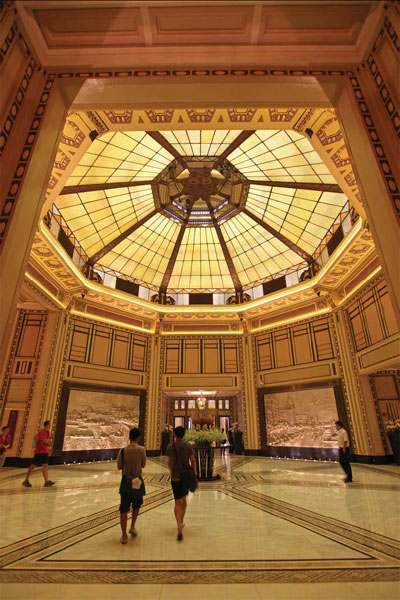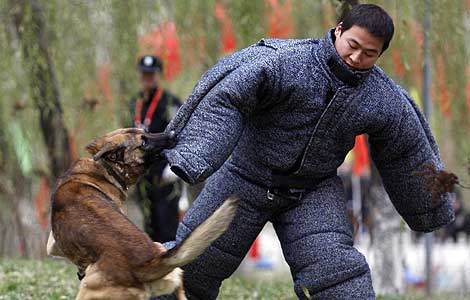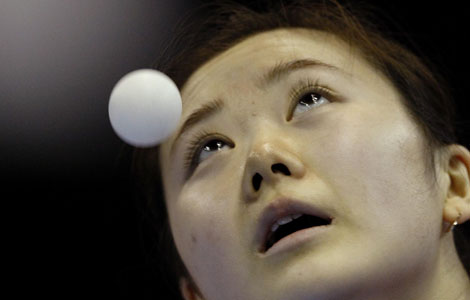A Shanghai jewel dazzles once more
Updated: 2011-12-02 07:34
By Shi Yingying (China Daily)
|
|||||||||
|
The grand entrance atrium is one of the most exciting features of the hotel. [Gao Erqiang / China Daily] |
The Peace Hotel has history to revel in, and now it's reliving its glory days after a three-year makeover
They are hopelessly in love with rivers, lakes, the sea and oceans, and are smitten with majestic old architecture.
Whether you are standing on the banks of the Nile in Cairo, near the Alster Lake in Hamburg, Germany, by Boston harbor in the United States, or on the edge of the Caribbean Sea in Barbados, you can be sure that the folks from Fairmont will be nearby.
So it was probably only a matter of time before the Canadian hotel chain would turn its attention to Shanghai. And how!
By night a green pyramid atop the landmark Peace Hotel glows a luminescent green, as if to say, "Look at me." And the look is well warranted for this Shanghai landmark a stone's throw from the Huangpu River, and which is now basking in its former glory.
When the Peace Hotel, which is more than 80 years old, reopened last year after a three-year renovation, sharp-eyed observers would have noticed it had become the Fairmont Peace Hotel, which, in view of all the work put in, is probably fair enough. The Chinese name has been kept.
Most Chinese are probably unaware of the upmarket Fairmont Hotels and Resorts, which has more than 60 hotels in 18 countries.
The hotel's general manager, Kamal Naamani, says the tie-up between Fairmont Hotels and Resorts of Canada and Jinjiang Hotels of China, the owner of the property, was only natural.
"We have been around for more than 100 years, and with our expertise in managing and restoring iconic heritage properties and operating them, we are known for our rich cultural experience."
To most Shanghainese, especially those who have a strong emotional tie with the Peace Hotel, it will always be exactly that, no matter what other name is attached.
"It's far more than a hotel for me, and takes me back to those glory days," says Tang Wuji, 77, who used to be a frequent guest. "I grew up with the hotel and it just takes me back to the best time of my life."
The hotel was feted as the finest in the Far East when it was first built, so it was only natural that an appropriate tribute be paid to that heritage when it reopened.
So a few months before the auspicious date, a call went out all over the world. The hotel wanted anyone who might have photos, pieces of furniture - and perhaps even a stolen spoon or two - to submit them for an exhibition that would showcase the hotel's, and the city's yesteryear charms.
"We invited people to share their stories," Naamani says. "Whether it was a menu, souvenir, uniform, or picture of special people staying at the hotel, we wanted to feature it in the hotel."
The gallery's relics hold lessons particularly for the young, he says.
"If you don't know what Shanghai looked like in the 1930s, coming to places like this will take you back to that era. You can start to understand what this hotel meant to the city."
Martin Ma, director of the Peace Gallery, located on the mezzanine floor, has worked for the hotel for 47 years and jokes that the only position that he has not tried is that of general manager.
"I was the doorman when I first got into Peace Hotel as a 17-year-old boy. I've worked at reception, the front desk and used to be a cashier."
Ma reckons he is the person best qualified to head the Peace Gallery, a meeting place for memories.
"The collection is a continuing process, and so far we've got about 80 pieces including antique tableware, porcelain and crystal that decorated the hotel's old rooms."
Jenny Lang-Peach, a Fairmont "heritage program consultant", conducts tours of the hotel that take in areas of the hotel regarded as important historically or architecturally.
Such areas include rooms belonging to the original and the roof on the ninth floor, which offers views of the Bund.
The hotel's restoration, which began in April 2007 and cost about HK$500 million ($64 million, 48 million euros), took longer than expected because of concerns for respecting and protecting the hotel's heritage and restoring it to its original look, says Yang Weimin, CEO of Shanghai Jinjiang International Hotel Group Co Ltd, which owns the hotel.
"It was not just about painting the wall. We really had to go back to find out what the original color of the wall was. Our heritage preservation expert climbed up to the ceiling and peeled more than five layers of paints to see its true color.
"We changed little. The only thing is the walls and ceilings now look new and fresh. Now you have the old building with its characteristics, soul and history, yet with modern amenities."
One of the most exciting features is the grand entrance atrium, which was in the original hotel and has been restored. Bringing back memories of the hotel's glory days, natural light will once again stream through the colorful glass roof into the atrium.
The return of the original Old Jazz Band is another bonus for Shanghai residents. The band was formed in 1980 and is said to have been the first jazz group in Shanghai after the country set about its economic reforms.
Even if age may have wearied the band's original members, most are still around, until recently their average age was 88 - older than the hotel - but one band member died. People from around the world enjoyed the band's foot-tapping music, including the US presidents Ronald Reagan and Bill Clinton.
"I don't think you can have a Jazz Bar at the Peace Hotel without the Old Jazz Band, so, they're back for good," Naamani says.












